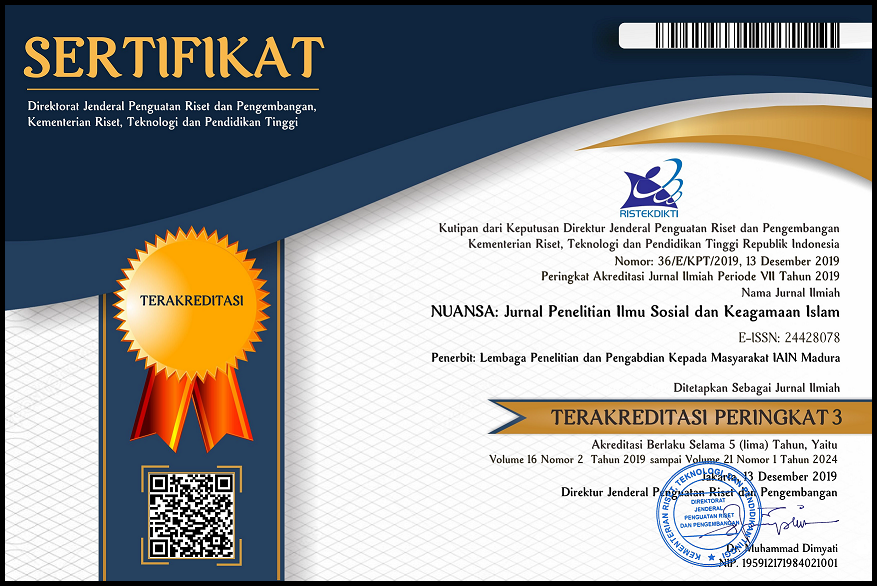KONSTRUKSI SOSIAL DAN LIVING QUR’AN DALAM TRADISI PEGON MASYARAKAT AMBULU KABUPATEN JEMBER
 Abstract views: 184
,
Abstract views: 184
,
 PDF downloads: 111
PDF downloads: 111
Abstract
The pegon tradition which is carried out every seventh day during Eid al-Fitr is an activity that has been passed down from generation to generation. This study examines the Pegon Tradition which is relevant to the living Qur'an and the perspective of social construction is reviewed using Peter L Berger's theory. The pegon tradition has undergone a long process and religious acculturation has experienced significant development influenced by the presence of the Living Qur'an in the community and it is known that the reciprocal process with the environment occurs in Ambulu residents through the reading of the letters al-Fatihah, al-Waqiah and al-Mu'awidzatain carried out by residents indicating that social construction has been formed. The results of this study are the presence of the Living Qur'an with a communal-massive community category indicating that there is an acculturation phenomenon that occurs in the implementation of the Pegon Tradition which has similarities with larung sesaji, but the difference lies in the way it is implemented. This is a form of gratitude for the sea products initiated by religious figures to change the habits of residents in the tradition by asking for prayers for protection from Allah SWT. The social construction in the implementation of the Pegon Tradition goes through three processes, namely externalization, objectivation, and internalization. This then made the pegon tradition maintained until now as an internalization process and became a routine activity every year.
Downloads
References
Alif, Naufaldi, Laily Mafthukhatul, dan Majidatun Ahmala. “AKULTURASI BUDAYA JAWA DAN ISLAM MELALUI DAKWAH SUNAN KALIJAGA.” Al’adalah 23, no. 2 (11 Oktober 2020): 143–62. https://doi.org/10.35719/aladalah.v23i2.32.
Berger, Petter L, dan Thomas Luckman. The Social Construction of Reality A Treatise in the Sosiology of Knowledge, t.t.
Hasan, Dr H Nor, M Ag, dan Dr Edi Susanto. “RELASI AGAMA DAN TRADISI LOKAL (STUDI FENOMENOLOGIS TRADISI DHAMMONG DI MADURA),” t.t.
Magfirah, St. “ULUL ALBAB DALAM AL-QUR’AN (TAFSIR TEMATIK).” Aqlam: Journal of Islam and Plurality 6, no. 2 (31 Desember 2021). https://doi.org/10.30984/ajip.v6i2.1650.
Maulana, Moh Ishaq. “‘Festival Pegon Sebagai Budaya Lokal Masyarakat Kecamatan Ambulu Kabupaten Jember Tahun 1989-2018’,” t.t.
Mukhlishin, Ahmad, Muhammad Jamil, dan Aprezo Pardodi Maba. “ASIMILASI ISLAM DENGAN BUDAYA LOKAL DI NUSANTARA.” Nurani: Jurnal Kajian Syari’ah dan Masyarakat 18, no. 1 (1 Januari 1970): 35–44. https://doi.org/10.19109/nurani.v18i1.2457.
Sugiarto, Fitrah, Ahlan, dan Nurwathani Janhari. METODOLOGI PENELITIAN LIVING QUR’AN DAN HADIS. Mataram: UIN Mataram Press, 2023.
Sumbulah, Ummi. ““Islam jawa dan Akulturasi Budaya: Karakteristik, Variasi, dan Ketaatan Ekspresif".” El-Harakah 14, no. 1 (2012): 51–68.
Copyright (c) 2025 NUANSA: Jurnal Penelitian Ilmu Sosial dan Keagamaan Islam

This work is licensed under a Creative Commons Attribution-NonCommercial 4.0 International License.
The journal operates an Open Access policy under a Creative Commons Attribution-NonCommercial 4.0 International License (CC-BY-NC) 
Authors who publish with this journal agree to the following terms:
- Authors retain copyright and grant the journal right of first publication with the work simultaneously licensed under a Creative Commons Attribution License that allows others to share the work with an acknowledgement of the work's authorship and initial publication in this journal.
- Authors are able to enter into separate, additional contractual arrangements for the non-exclusive distribution of the journal's published version of the work (e.g., post it to an institutional repository or publish it in a book), with an acknowledgement of its initial publication in this journal.
- Authors are permitted and encouraged to post their work online (e.g., in institutional repositories or on their website) prior to and during the submission process, as it can lead to productive exchanges, as well as earlier and greater citation of published work.





















